Scroll through the lesson and click on notation/video/audio links to load the interactive players.
Please subscribe to get full access to all lessons for only $7.95/month PLUS 1 week free trial.

Riff Interactive lessons are
LESS expensive and
MORE interactive than alternatives!
More Info
|
|
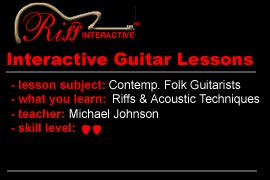
Teacher: Welcome class to the lesson on
Contemporary Folk Guitarists. In this lesson you will learn how to play in the
style of Dave Matthews! Dave's roots are in folk, but he has added some very
intriguing styles to create his sound. Dave will use folk guitar and add
jazz, rock, reggae, funk,... whatever to create his very unique and compelling sound. Check
out the lesson sample of what you will learn.
Lesson Sample - Lowband - 817k
Lesson Sample -
Highband - 3.2 Meg
Teacher: Our first
part starts off with a standard folk sounding piece, then it progresses from
there. Here's the intro.
Part 1 - Intro
Part 1 -
Intro
Part 1 - Intro -
Picking
Teacher:
You might notice that the first chords can be a challenge to play. You start wit
the C add9 chord which is common in folk and country, but then you add the F 6/9
which has some very interesting voicings. Here's a picture of each
chord.
C
add9
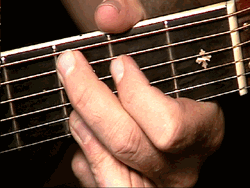
F
6/9
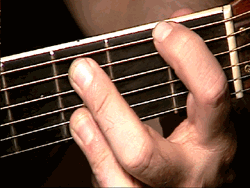
Teacher: Keeping the 3rd finger anchored on the
1st & 2nd string/3rd fret is important while the other fingers shift between
the other chords. Here's the jam track for this part.
Looping Jam
Track 1 - Lowband
Jim: I'm
finding it easier to use 3 on the B string and 4 on the E
string...
Teacher: Jim, yes that will work. In fact that is
a common alternative fingering used among guitarists who play those chords. Let's jump to
the next intro part. This section starts off with a rake using a D Major
arpeggio/chord. Here's the part.
Part 2 - Intro
Part 2 -
Intro
Teacher:
Notice how you play the Em add9, A add9 and G add9 after the rake in D. The
add9 chords can be a challenge to play. Here's a picture of some of the chords.
Em
add9

A
add9
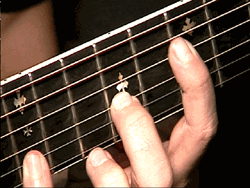
Teacher: You have quite a stretch while playing
these chords. Make sure the thumb is planted firmly on the back of the neck to
help fret these chords. Here's the jam track for this
section.
Looping
Jam Track 2 - Lowband
Teacher: Does
anybody recognize any bands that use these chords?
Drew: Crosby, Stills, Nash and
Young
Teacher: Drew sometimes. How about the Police or
Rush. The Police use these chords in songs like "Message in A Bottle," "Every
Breath You Take," and songs like that.
Drew: Rush your correct, they put more drive over it.
Teacher:
You bet Drew!
kewlpack:
Satriani's Circles uses the add9 eh?
Teacher: Satriani is a great example of players
who use add9 chords!
kewlpack: Whew - that Gmadd9 is crazy stretching for my
small hands.
Teacher: Yes it is kewlpack, this will be an
excellent exercise to increase the stretch of your hand. Be careful these chords
will be painful after awhile. Let's jump to the next part. Dave Matthews also
takes a folk sounding progression and add a jazz rock or reggae rhythm pattern.
Here's the next part.
Part 3 - Riff
Part 3 -
Riff
Teacher:
In this section however we'll continue to use the add9 chords in a slow jazz
rock beat. Notice once you have the add9 chord down you can move it into various
positions. Here's the picture for the E add9 chord and A add9 chord.
E add9 -
Open
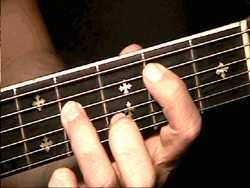
A
add9 - 5th Fret
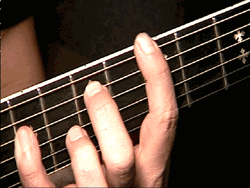
Teacher: The open E add9 is pretty easy, the
fretted A add9 & G add9 is a little more difficult. Here's the jam track for
this section.
Looping Jam Track 3 - Lowband
Teacher:
Notice how the guitar layers nicely with the keys and bass tracks. The ascending
chords towards the end of the phrase are actually pretty easy to
play. Notice how the chords ascend on the 5th string, while you have a
pedal tome note that drones on the open 3rd string (G). Let's jump to the
next section. In this art you continue to use the add9 chords, but this time
with more syncopation. Here's the part.
Part 4 - Riff
Part 4 -
Riff
Teacher:
This section uses all add9 chords, but shifts from position to position. Notice
how the 2nd part of the phrase alters the chords used. Here's the looping jam
track for this section.
Looping Jam Track 4 - Lowband
kewlpack: Would
sound hot with some delay ;)
Teacher: It sure would, that's a great idea! Now
Dave Matthews was inspired by many folk guitars and other musicians, but one
folk artist who took folk outside of the traditional style is Joni Mitchell.
Dave carried this flag to branch outside of traditional
folk.
Jim:
Picking? I'm use down-down-up, which seems to flow nice and give punch to the
last note of each triplet.
Teacher: Jim, yes that is the picking pattern I'm
using as well. You can use all down-strokes as well, to add extra attack. You can
even palm mute the strings using you picking hand to add additional attack as
well. The next part uses more standard folk chords, but with a different rhythm
pattern. Here's the next section.
Part 5 - Riff
Part 5 -
Riff
Teacher:
In this section you hold down the B add9 chord and pick the various parts of the
chords using a syncopated strumming
pattern. Here's the jam
track.
Looping Jam
Track 5 - Lowband
Teacher:
Notice how the guitar adds extra rhythm over the other tracks. Another folk
guitarist who uses this technique is Ani DiFranco, who will be featured later in
this series. Dave Matthews will also occasionally through in a
straight sounding rhythm pattern and chords in for the chorus to add a commercial edge to the sound
of a song. This seems to bring the syncopated parts together giving a sense of resolve.
Here's the next part.
Part 6 - Riff
Part 6 -
Riff
Teacher:
Using simple chords can also add to the dynamics of the song. Here's the jam
track.
Looping Jam
Track 6 - Lowband
Teacher:
Dave also will play single-note melody lines the compliment the other
instruments. Here's an example.
Part 7 - Riff
Part 7 -
Riff
Teacher:
This melody uses the A Mixolydian mode. This mode has A, B, C#, D, E, F# G which
is relative to D Major (Ionian) D, E, F#, G, A, B, C#. Here's the scale
pattern.
A
Mixolydian
Teacher:
Listen how the single-note guitar melody compliments the other instruments in
the looping jam track.
Looping Jam Track 7 - Lowband
Teacher:
The bass and sax plays a counter melody, while the guitar does its own thing.
Well that's it for this lesson, I hope you have a better understanding of the
style of Dave Matthews.
Teacher: See you next
lesson!
kewlpack: Good stuff teach,
thanks!
Teacher: Thanks!
|
<< load notation from left
|
|
<< load audio from left
|
<< load audio from left
|